Ever wondered about the beating heart of your bike, that magic component making your two-wheeled wonder come alive? Its the crankset. Much like an orchestra conductor waving his baton to create symphonies, a crankset harmonizes every stroke of our pedal into motion.
You might have heard seasoned cyclists passionately debate over ‘double’ and ‘triple’ cranksets or seen them examining their bikes with expressions as serious as a surgeon. What’s all this fuss about?
This isn’t just some geeky cycling jargon; it’s at the core of how you experience each ride. From conquering steep mountain trails to breezing through city roads, picking the right crankset can make all the difference.
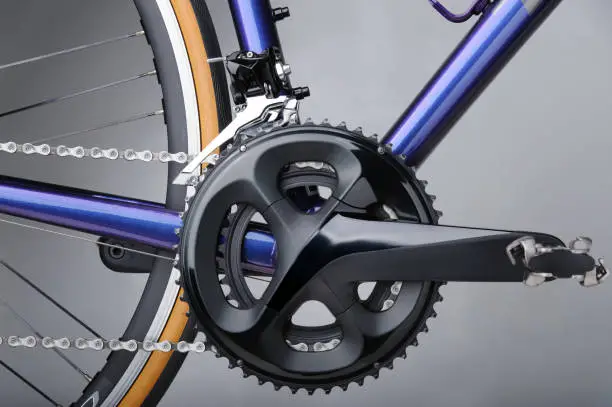 Bike Crankset
Bike Crankset
Join me as we uncover the mysteries behind those spinning pedals, shedding light on secrets that have remained hidden for so long.
Table Of Contents:
- Understanding the Basics of Cranksets
- Types and Variations of Cranksets
- Detailed Features and Components of Cranksets
- Crankset Brands and Models Comparison
- Choosing the Right Crankset for Your Bike
- Installation and Maintenance of Cranksets
- Expert Recommendations and Tips on Cranksets
- FAQs in Relation to What is Crankset
- Conclusion
Understanding the Basics of Cranksets
A crankset is more than just a set of pedals on your bike. It’s a crucial part of your bicycle’s drivetrain, serving as the connection point between your leg power and the spinning wheels that get you moving forward.
The crankset consists typically of two parts: crank arms and chainrings. The number of chainrings on a crankset varies, depending on the type and purpose of the bike.
Crank arms are levers extending from the bottom bracket, which is where they attach to your bike frame. They’re responsible for transferring energy from each pedal stroke into turning motion.
What is a Chainring?
In simple terms, chainrings are round metal discs with teeth along their edges. These latch onto your bike’s chain when you pedal, propelling it around to drive momentum in either direction.
The crankset size or number (called ‘chainrings’) directly impacts how hard or easy it will be to turn those pedals over hills or flat surfaces alike – this is why many bikes have multiple ones for varying terrain conditions.
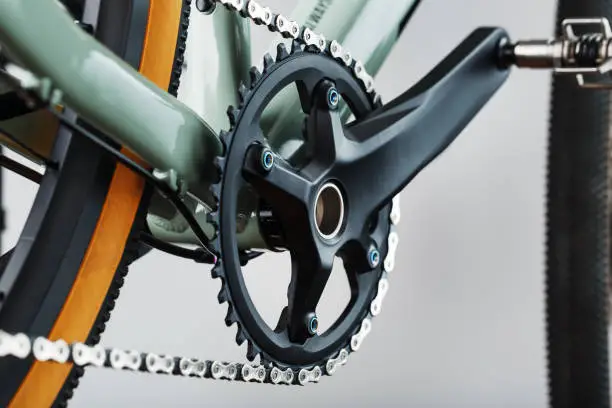
Cranking up Your Cycling Experience
If cycling were music then consider cranks like drumsticks while chains serve as cymbals; together creating rhythmic harmony allowing riders traverse roads effortlessly no matter gradient steepness nor distance covered. Remembering fact gear ratios greatly influenced by these components’ configuration helps better comprehend importance attached selecting suitable models fitting individual needs perfectly well.
Crankset Types and Variations
The crankset is a vital component of your bike’s drivetrain, playing an integral role in transferring power from the rider to the wheels. There are several variations, each with unique features tailored for specific riding conditions.
Single-ring vs Double vs Triple Cranksets
A single-ring crankset has just one chainring attached to the cranks. It offers simplicity and weight savings but lacks versatility in gear range. However, modern designs often incorporate wide-range rear sprockets to compensate for this limitation.
In contrast, double and triple cranksets offer greater flexibility in gear ratios due to multiple chainrings on the front. For instance, road bikes commonly use compact double cranksets that provide a wide range of gears while keeping weight low.
Touring bikes or mountain bikes may feature triple chainset systems due their need for an even wider gear ratio spread. These help tackle steep terrains by providing more lower-end gearing options alongside high-speed ones.
Compact Cranksets
A popular choice among cyclists seeking balance between performance and comfort is the Shimano GRX gravel groupset. This compact setup lets you cover broad speed ranges without having huge jumps between shifts; making it perfect for mixed-terrain rides such as those involving both pavement sections and off-road trails.
Cyclists can choose different combinations based on individual preferences or needs – whether it’s maintaining higher cadence with smaller chainrings or generating more force using larger ones – allowing everyone from novices through experts enjoy cycling at their own pace.
It’s worth noting that regardless if you’re cruising down North America’s bike lanes or grinding up a gravel groupset on a mountainous trail, cranksets generally have one thing in common: they all serve as the main connection point where your pedals attach to the bike frame. This is why understanding their types and variations can make sure you get optimal performance from your ride.
So whether you’re considering swapping out an entire crankset or just changing chainring sizes, remember to keep experimenting. Finding the ideal configuration for you is a process of experimentation and exploration tailored to your individual style and requirements. It’s a process of trial and error that eventually leads you to the perfect setup.
Whatever type of crankset you choose, it’s key to find the right balance for your riding style. Single-ring setups give simplicity and weight savings, but they may limit your gear range. On the other hand, double or triple configurations offer more versatility for diverse terrains with multiple front chainrings. Compact cranksets like Shimano GRX strike a great blend of performance and comfort, making them an excellent choice for rides on mixed terrain.
Detailed Features and Components of Cranksets
The heart of your bike’s drivetrain is the crankset, a key component in determining gear ratios and influencing riding comfort. But what exactly does it consist of?
Crank Arm Length
The crank arm is where pedals attach to the bike. Crank arm length can range from 165mm to 175mm, with the most common size in North America being 172.5mm. Riders should choose their crank lengths carefully as they directly affect pedal efficiency.
Smaller riders or those preferring a higher cadence might opt for shorter cranks while taller cyclists may prefer longer ones. So, don’t underestimate this tiny part; it can make or break your ride.
Chainrings sizes and Bolt Circle Diameter (BCD)
On a typical double or triple chainset you’ll find two or three rings called chainrings mounted on the spider – an extension of the drive-side crank arm that holds these gears together.
A smaller inner ring will give easier gearing for climbing steep hills while larger outer chainring lets you go faster on flat terrains. Swapping out these toothed wheels isn’t always straightforward due to compatibility issues but gives you flexibility in adjusting your gear range.
The bolt circle diameter (BCD) measures how far apart these bolts are around a circle diameter formed by their centers – think pizza slices. The BCD dictates which replacement chainrings will fit onto your existing spider – so jot down this number before shopping for new gears.
Direct-mount interfaces vs traditional spiders
- In direct-mount setups like some modern designs offered by SRAM, the chainring mounts directly onto the crank arm – offering greater versatility and ease in swapping gears.
- On traditional spider setups, chainrings bolt to a separate piece attached to the crank arm. They can be more complex but have stood the test of time with their proven reliability.
In conclusion, understanding these features is key to picking the right bike crankset that matches your ride style. Whether you’re tackling steep mountain trails or relishing in leisurely road tours, make sure you’re well-equipped.
Understanding Your Bike’s Crankset: The crankset is the heart of your bike’s drivetrain. Its components, including the crank arm length and chainring sizes, directly influence your ride. Shorter cranks are ideal for smaller riders or those preferring higher cadence while longer ones suit taller cyclists. Chainrings play a vital role too; smaller ones can make pedaling easier but reduce speed, perfect for steep climbs.
Crankset Brands and Models Comparison
When it comes to bike cranksets, three major brands dominate the market: Shimano, SRAM, and Campagnolo. Each of the companies provides an array of models to suit different cycling requirements.
Shimano, originating from Japan and widely popular in North America, provides various options for all types of bikes. For instance, their Dura-Ace Di2 R9200 groupset is highly sought after by road cyclists due to its superior quality and performance.
SRAM, an American brand known for innovative designs like the single-ring crankset or ‘1x’ system (pronounced “one-by”), makes gear shifting simpler with fewer components involved. The Red eTap AXS groupset, one of their top-tier offerings delivers crisp shifts even under heavy loads – perfect for competitive riders.
Detailed Look at Different Models
In terms of pricing across these brands you can expect a broad spectrum – ranging from $100 up into four figures ($1000+). Let’s look more closely at what each brand has on offer:
 The Shimano Dura-Ace R9100 Crankset – favored among professionals because it achieves the ideal balance between weight reduction and rigidity making it excellent for high-speed racing.
The Shimano Dura-Ace R9100 Crankset – favored among professionals because it achieves the ideal balance between weight reduction and rigidity making it excellent for high-speed racing.
 The SRAM Force 22 Crankset, a mid-range model suitable both road biking enthusiasts as well as competitive racers thanks to its durable design and wide gear range.
The SRAM Force 22 Crankset, a mid-range model suitable both road biking enthusiasts as well as competitive racers thanks to its durable design and wide gear range.
 The Campagnolo Super Record 12 Speed Crankset, which stands out for its carbon fiber construction, providing stiffness and lightness – it’s a high-end choice for serious cyclists who are ready to invest in performance.
The Campagnolo Super Record 12 Speed Crankset, which stands out for its carbon fiber construction, providing stiffness and lightness – it’s a high-end choice for serious cyclists who are ready to invest in performance.
In conclusion, when selecting a crankset, factors such as your cycling style, the type of bike you have (road or mountain), desired gear range and budget all come into play. But whether you’re looking at Shimano offers or Campagnolo designs there is something suitable available in each brand’s lineup.
Choosing the Right Crankset for Your Bike
Choosing a crankset is like picking out an engine for your car. It’s not merely about magnitude or potency, but how it synchronizes with the rest of your bike.
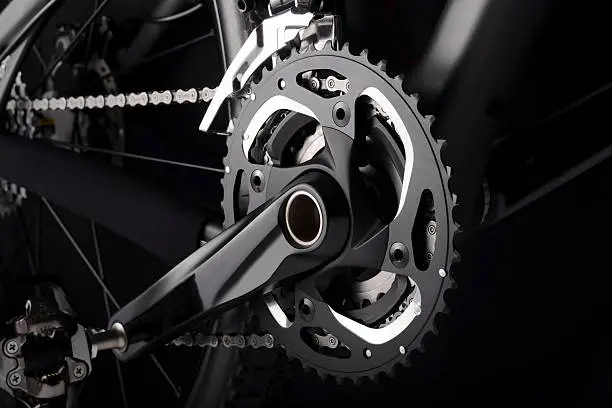
The Type of Bike Matters
Your bike type plays a huge role in deciding which crankset to get. Road bikes typically need compact cranksets due to their wide gear range and high-speed requirements. On the other hand, mountain bikes require sturdy cranksets capable of handling off-road riding conditions.
Gear Range Considerations
When selecting a crankset, you also have to consider gear range – basically how easy or hard it is to pedal at different speeds. For example, touring bikes generally use triple chainsets that offer lower gears making uphill rides more manageable.
Budget and Compatibility Checks
Cranksets can vary greatly in price; from $100 up to over $1000 if you’re considering top-end models like SRAM Red eTap AXS groupset. But before busting your wallet open, make sure any potential buy fits well with existing bicycle components such as bottom bracket standards and chain length.
Different Bottom Bracket Standards Exist.
Note: Not all cranks fit into every bike frame. Different bottom bracket standards exist; choosing one that’s compatible with both your chosen crankset and bike frame is crucial. You don’t want them fighting each other now do we?
Installation and Maintenance of Cranksets
A bike crankset is like the heart of your bicycle’s drivetrain. Installing it correctly, and keeping it well-maintained, can help you pedal with less effort while enjoying more speed.
Installing a Crankset on Your Bike
To start installing a new crankset, first make sure that your bottom bracket is compatible with the chosen model. You might need specific tools for this job depending on whether you have an external or internal bearing bottom bracket.
The next step involves sliding one of the crank arms onto the spindle protruding from the right side of your bottom bracket shell. Once secure, attach chainrings to this arm if they’re not already installed.
You then repeat these steps for attaching another arm to the opposite end of the spindle through the left side BB shell, but remember: ensure both cranks align at 180 degrees to each other.
Maintenance Practices For Optimal Performance
Bicycle components are designed to withstand tough conditions, but giving them some TLC extends their life significantly. A clean bike also means better performance, so regular cleaning and lubrication should be part of any cyclist’s routine. It’s always a good idea to keep chainrings free from grime build-up as dirt particles can accelerate wear and tear. Replacing worn-out parts when necessary, such as chainrings after around 20k miles or once teeth become noticeably ‘shark fin’ shaped, helps maintain optimal drive efficiency – don’t wait until things break.
If you hear anything out of the ordinary or detect any loose components, don’t wait to take your bike in for a professional assessment. If you observe anything unusual, don’t hesitate to have a pro examine your bike.
The Bottom Line
your ride’s safety and longevity. Regular checks and upkeep not only help keep your bike in top shape but also guarantee a smooth, hassle-free riding experience. Whether you’re exploring the scenic routes of North America or just commuting locally, maintaining your bicycle is an essential task for every rider.
Proper crankset installation and upkeep: These are key to a smooth, effortless ride. Make sure your bottom bracket is compatible before you start installing. Regular cleaning, lubrication, and replacing worn-out parts like chainrings extend the life of your bike components. Remember: Always check for unusual noises or loose parts.
Expert Recommendations and Tips on Cranksets
When it comes to cranksets, upgrading for improved performance can make a significant difference in your ride. A high-quality crankset lets you optimize gear ratios and cadence, translating into smoother rides and more power.
Adjusting Crank Length
A common question among cyclists is how to adjust the crank length for optimal comfort and power. The answer depends on factors like rider height, bike frame size, riding style, and personal preference. Most riders find that cranks between 165mm to 175mm work best. Power meters can help you measure the impact of different lengths on your cycling efficiency.
You might need shorter cranks if you have smaller proportions or prefer a higher cadence. On the other hand, longer ones could be better if you’re taller or favor low-cadence mashing.
Maintenance Practices
To keep your crankset running smoothly, maintenance is key.
Cleaning after every ride helps prevent dirt buildup which can wear out components faster. Lubricating chainrings regularly ensures smooth transitions between gears while reducing friction – this prolongs component life significantly.
If signs of wear start showing up – such as skipping chains or difficulty shifting gears – it’s probably time for an upgrade. Shimano Dura-Ace Di2 R9200 groupset, SRAM Red eTap AXS groupset, and Campagnolo Ekar gravel groupset are excellent options to consider for their performance, quality, and durability.
double to a single chainring setup. Keep in mind, replacing the whole crankset could be beneficial if you’re thinking about making major changes to your gear range or planning to shift from a double-chainring configuration to a single one.
FAQs in Relation to What is Crankset
What is the purpose of a crankset?
A crankset converts your pedaling power into movement, driving the bike’s chain and rear wheel forward.
How do I know what crankset I need?
You’ll need to consider factors like your bike type, gear range needs, compatibility with other components, and budget when picking a crankset.
What is the difference between chainring and crankset?
The chainring attaches to the cranks in a set-up called a “crankset”. Cranks are levers that connect pedals to chainrings. Chainrings engage with chains for propulsion.
Does a crankset include a bottom bracket?
Nope. While connected by design functionally speaking, you typically purchase bottom brackets separately from your chosen cranksets.
Conclusion
So, you’ve now ventured into the world of cranksets. Understanding what a crankset is and how it works on your bike was our first step.
You got to know about different types like single-ring, double, triple or compact ones. Each has its own charm depending on the ride conditions and personal preferences.
We dived deep into chainring sizes, bolt circle diameters (BCD), and arm lengths that all contribute towards perfecting your cycling experience.
The array of brands available might have surprised you; Shimano, SRAM or Campagnolo each offering unique features at various price points. Remember when choosing one for yourself to consider compatibility with other components as well as gear range requirements based on your biking needs.
Maintenance? It’s simple: keep it clean, lubricate regularly and replace worn out parts in time – just common sense!
All this wisdom equips you better than ever before to pick a winner from any lineup of bicycle cranksets! So get out there and give those pedals a whirl with newfound confidence knowing exactly ‘what is Crankset’ doing under your feet while making every ride an unforgettable journey!

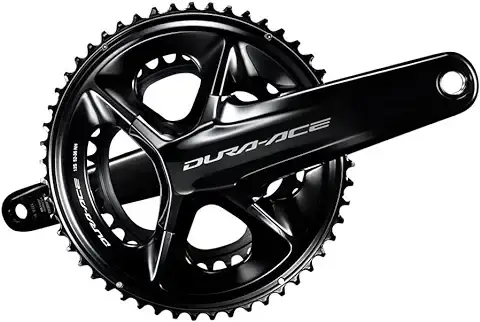 The Shimano Dura-Ace R9100 Crankset – favored among professionals because it achieves the ideal balance between weight reduction and rigidity making it excellent for high-speed racing.
The Shimano Dura-Ace R9100 Crankset – favored among professionals because it achieves the ideal balance between weight reduction and rigidity making it excellent for high-speed racing.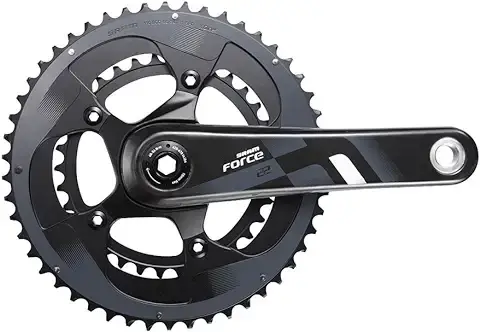 The SRAM Force 22 Crankset, a mid-range model suitable both road biking enthusiasts as well as competitive racers thanks to its durable design and wide gear range.
The SRAM Force 22 Crankset, a mid-range model suitable both road biking enthusiasts as well as competitive racers thanks to its durable design and wide gear range.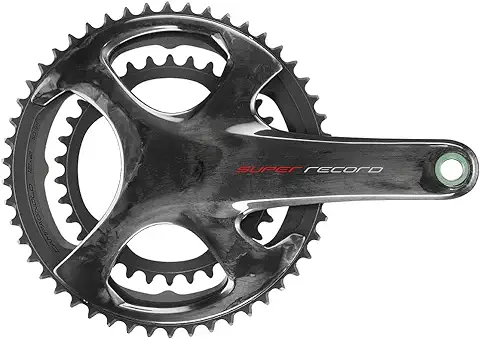 The Campagnolo Super Record 12 Speed Crankset, which stands out for its carbon fiber construction, providing stiffness and lightness – it’s a high-end choice for serious cyclists who are ready to invest in performance.
The Campagnolo Super Record 12 Speed Crankset, which stands out for its carbon fiber construction, providing stiffness and lightness – it’s a high-end choice for serious cyclists who are ready to invest in performance.